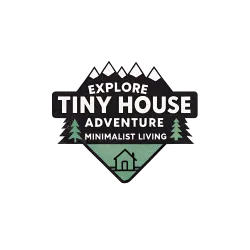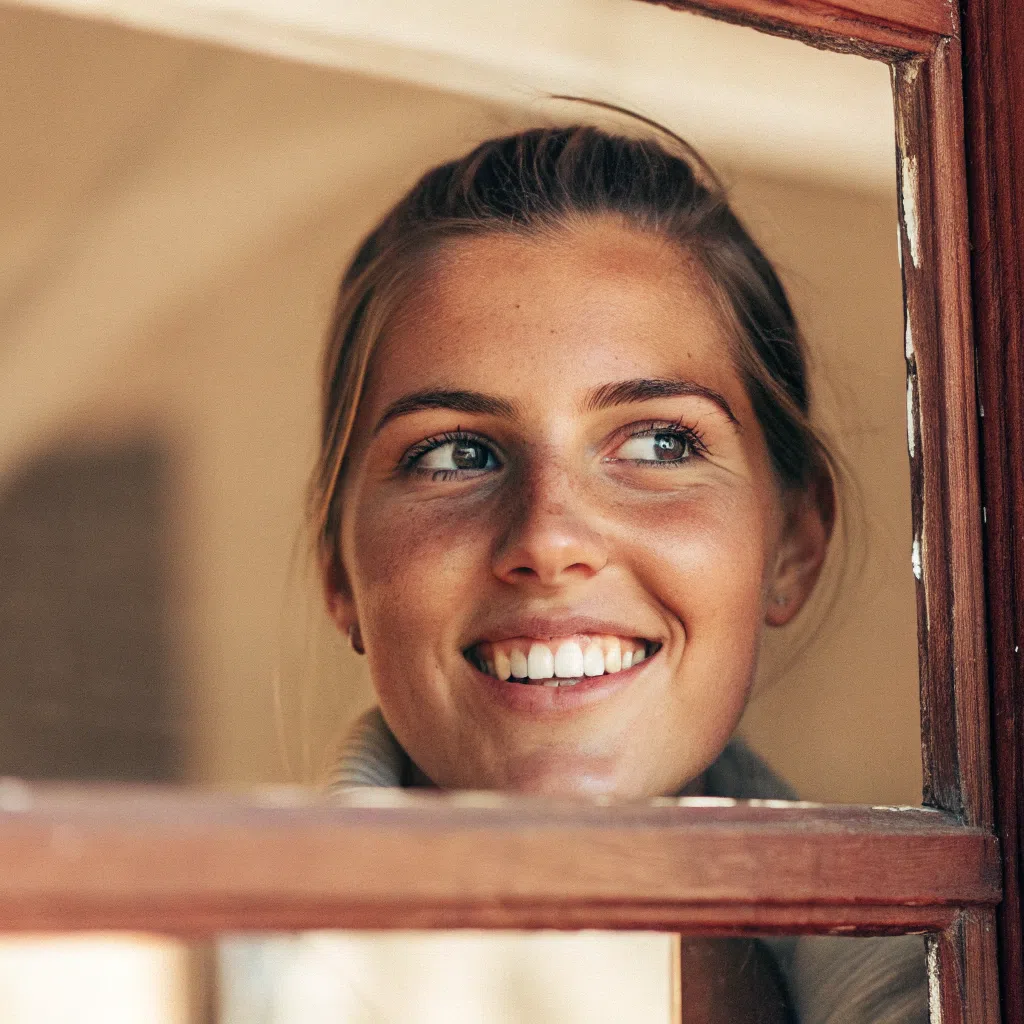Tiny house plans can feel like a puzzle waiting to be solved.
Where do you even start?
What’s the cost? Can you fit all your stuff in such a small space?
It’s a mix of excitement, curiosity, and maybe even a little hesitation.
But here’s the magic…
With the right plan, your tiny house can become a castle—small but mighty, practical yet beautiful.
Today, I’ll walk you through the essentials and tips for picking the perfect tiny house plan, including must-have amenities that make your tiny house both practical and beautiful.
Grab a cup of coffee (or tea) and let’s dig in.
Introduction to Tiny Houses
Tiny houses are small, portable homes typically built on wheels, with a total living area of less than 600 square feet. Tiny house plans generally range from a minimum of 60 square feet up to 600 square feet of space. The tiny house movement emphasizes simplicity, sustainability, and affordability, making it an attractive option for those seeking to downsize and reduce their carbon footprint. Tiny house plans often feature compact floor plans, innovative storage solutions, and sleek modern designs to maximize space and minimize waste.
These versatile homes can serve as permanent residences, vacation homes, or even budget-friendly starter homes. Available in a range of architectural styles, including modern, rustic, and minimalist, tiny houses cater to diverse tastes and preferences. With the rise of tiny house living, many people are discovering the benefits of tiny house plans, including reduced environmental impact, lower costs, and a more streamlined way of living.
- Why Tiny House Plans Matter
- Benefits of Tiny House Living
- How to Choose the Right Tiny House Plan
- Space Without Sacrifice
- Budgeting Your Tiny Home Build
- Financing Your Tiny House
- Insuring Your Tiny House
- Zoning and Legal Talk
- Tiny Houses as Investment Properties
- Green Living, Big Rewards
- Downsizing Without Regret
- Design for Every Need
- Materials That Go the Distance
- Add Your Personal Spin
- Wrapping It Up
Why Tiny House Plans Matter
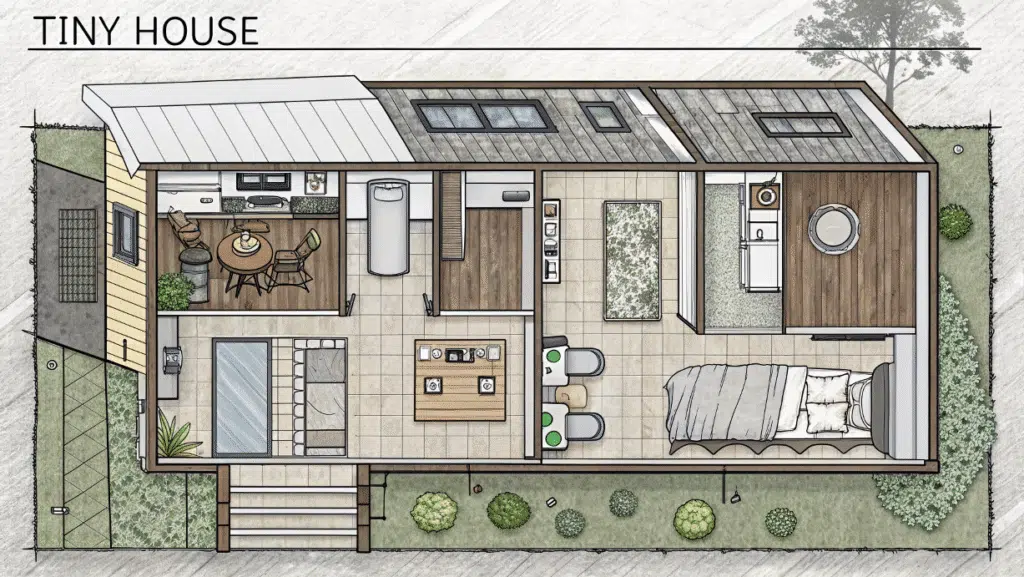
A tiny house is like a ship. Without a plan, it doesn’t sail smoothly.
Your tiny house plan is the blueprint.
It decides layout, comfort, and how well it fits your lifestyle. Tiny house plans can also serve as a budget-friendly starter home, making them an attractive option for first-time homeowners.
Think of it as a recipe for your dream home.
And the good news? There’s a plan out there for everyone. Whether you like to keep it simple or add a personal touch, it’s all possible.
Benefits of Tiny House Living
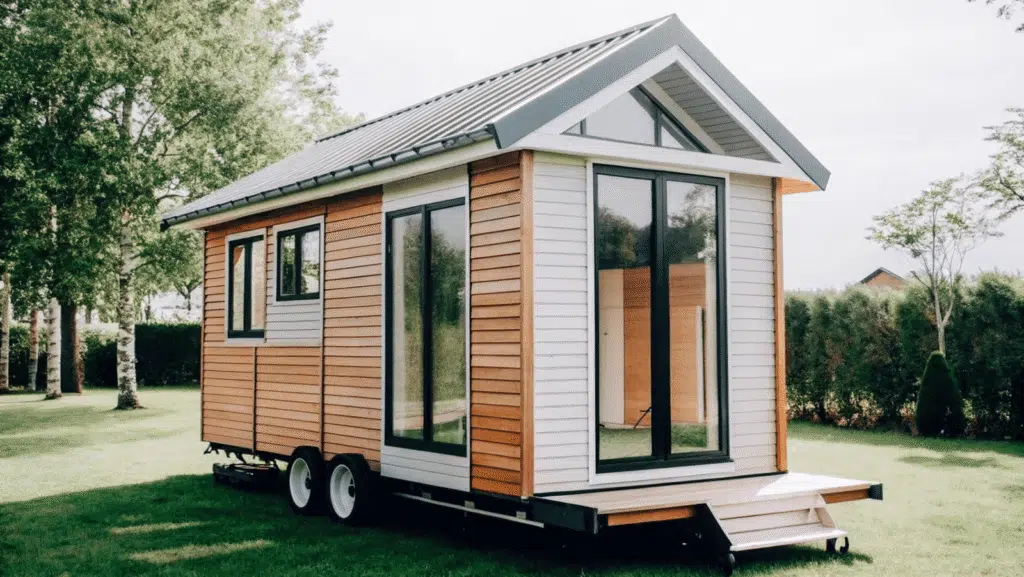
One of the primary benefits of tiny house living is the reduced cost of living. Tiny homes require less energy for heating, cooling, and lighting, and have lower maintenance costs compared to traditional houses. This lifestyle also promotes minimalism, encouraging homeowners to prioritize what is truly important and reduce clutter and waste.
Tiny houses often feature outdoor living spaces, such as front porches and decks, which can increase the living area and provide a connection to nature. Many tiny house designs incorporate cozy porches, patios, or decks to extend living areas. The compact size of tiny houses makes them ideal for small families or individuals looking to downsize or simplify their lives. Additionally, tiny house living can significantly reduce one’s carbon footprint, as these homes typically require fewer resources to build and maintain than traditional houses.
How to Choose the Right Tiny House Plan
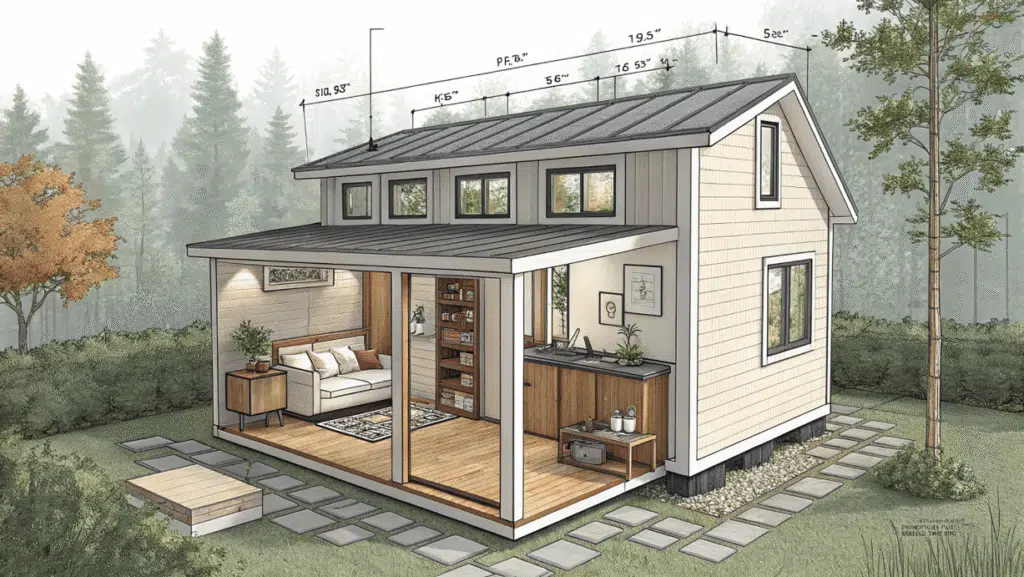
When choosing tiny house plans, start with you.
Ask yourself a few questions, like you’re chatting with a friend.
- What do I absolutely need?
- How much space do I really use daily?
- Do I want it mobile or on a foundation?
Given the limited square footage, it’s crucial to choose a plan that maximizes every inch of space.
Here’s what I recommend looking for to tailor it to your life.
Essentials to Think About
- Lifestyle First: Bedrooms big enough for your needs or a kitchen suited to how much you like cooking.
- Mobility: Do you need wheels? If so, look for weight-friendly designs.
- Family or Solo Living: The size changes fast if two people or pets are in the picture.
- Garage: Consider if you need a garage for additional storage or vehicle parking.
Pick the plan that feels like home even before it’s built.
Space Without Sacrifice
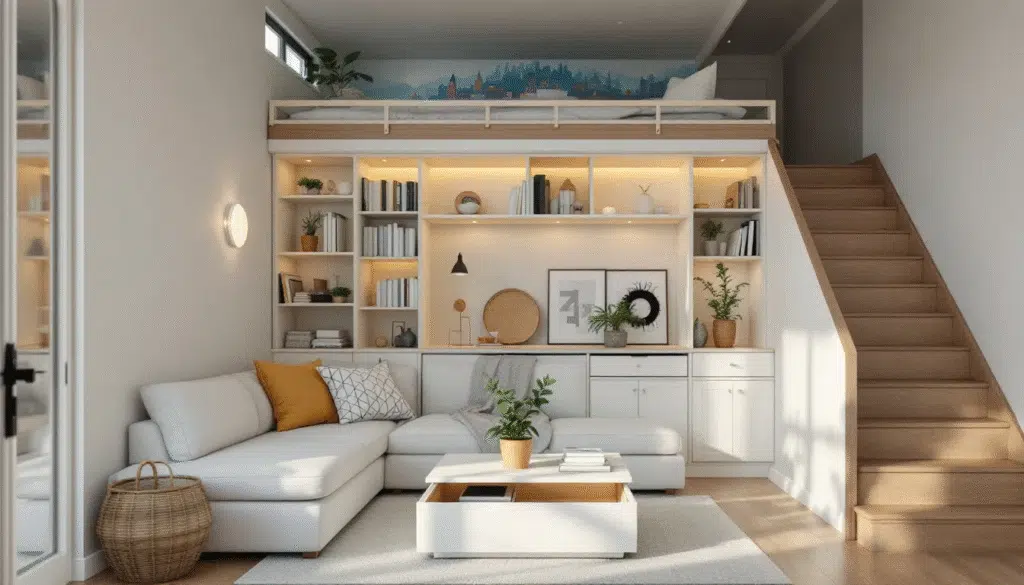
Tiny homes love clever solutions to create functional and inviting spaces.
Think of it this way… your furniture should do the heavy lifting.
Here’s how to make small spaces work twice as hard.
Smart Space-Saving Tricks
- Multi-Purpose Furniture: Beds that are also storage. Tables that fold out. Total game changers.
- Vertical Rules: Stack shelves and use every inch of wall space. Think high, not wide.
- Hidden Gems: Always look for hidden storage options under stairs or benches.
- Loft Areas: Utilize lofts for additional sleeping or storage space.
Tiny doesn’t mean cramped. Designed right, it’s cozy like your favorite hoodie.
Budgeting Your Tiny Home Build
Costs can haunt dreams, right?
But tiny houses are much more affordable than traditional ones. And with a few hacks? You can save even more.
Break It Down
- Plans: Pre-made designs are often cheaper than custom. Tiny houses are typically under 600 sq ft, which can significantly reduce building costs. Building a tiny house yourself can save about half of the cost compared to hiring a professional.
- Materials: Check out reclaimed wood or discounted materials at building yards.
- DIY or Builder: Doing it yourself saves, but pros save you time and headaches.
Pro tip? Stick with a budget but also leave room for occasional surprises. Turns out, they always happen.
Financing Your Tiny House
Financing a small house can be difficult, as traditional mortgage options may not be available for homes under a certain square footage. However, there are alternative financing options available, such as personal loans, RV loans, and construction loans, which can be used to finance the purchase or construction of a tiny house. Some lenders also offer specialized tiny house financing options, providing more flexible terms and lower interest rates.
It’s important to consider the cost of land or a trailer when financing a tiny house, as these costs can add up quickly. Homeowners can also explore government-backed loan options, such as FHA or VA loans, which may offer more favorable terms for tiny house purchases. By exploring these options, you can find the best financing solution for your tiny house dream.
Insuring Your Tiny House
Insuring a tiny house can be complex, as traditional homeowners insurance policies may not cover homes under a certain square footage. However, there are specialized insurance options available for tiny houses, providing coverage for the home and its contents. Some insurance companies offer policies specifically designed for tiny houses, offering more comprehensive coverage and lower premiums.
When selecting an insurance policy, consider the value of your tiny house and its contents, as well as any additional features or upgrades that may affect the policy. It’s also important to shop around and compare insurance quotes from multiple providers to find the best option for your tiny house. By doing so, you can ensure that your tiny house is adequately protected.
Zoning and Legal Talk
Here’s where tiny houses tangle with rules. Not every city loves them. No states expressly outlaw tiny house plans in the US. Before falling in love with a design, check the zoning laws where you plan to park or build your home. As a homeowner, it’s crucial to understand the local regulations to avoid legal issues.
Not every city loves them.
Before falling in love with a design, check the zoning laws where you plan to park or build your home. As a homeowner, it’s crucial to understand the local regulations to avoid legal issues.
What to Double Check
- Permits: Always, always file for them.
- Location Friendly? Some areas only allow tiny homes on wheels. Others… not so much.
- Covered Outdoor Areas: Ensure your design includes covered porches or decks if required by local codes.
Stay ahead of legal headaches. It keeps things smooth (and stress-free).
Tiny Houses as Investment Properties
Tiny houses can be a great investment opportunity, as they can be rented out on platforms like Airbnb or used as vacation rentals. The compact size and lower maintenance costs of tiny houses make them an attractive option for investors, who can generate passive income through rental income. Tiny houses can also be used to diversify a real estate portfolio, providing a unique and potentially lucrative investment opportunity.
However, it’s essential to consider local regulations and zoning laws regarding tiny houses, as well as any restrictions on short-term rentals. With the rise of tiny house living, the demand for tiny house rentals is increasing, making it an excellent time to invest in a tiny house as a rental property. By doing so, you can potentially generate a significant return on investment while contributing to the growing tiny house movement.
Green Living, Big Rewards
Tiny houses are a natural match for sustainability fans.
They use fewer materials, eat up less energy, and can run on solar power, all while harmonizing with their natural surroundings.
Want to make yours eco-friendly?
Add Green Touches
- Solar Panels: Power your house right from the sun.
- Water Collectors: Save on bills and help the planet.
- Recycled Materials: They aren’t just eco-friendly—they’re trendy.
- Modern Amenities: Incorporate energy-efficient appliances and fixtures to enhance sustainability.
Your tiny house can save big in more ways than one.
Downsizing Without Regret
Downsizing embodies the idea of simplifying your life and focusing on what truly matters.
What stays? What goes?
It might feel overwhelming, but it’s also freeing.
Tips for Downsizing
- Start Slow: Room by room works best.
- Set Limits: If you haven’t used it in a year, it’s time to say goodbye.
- Only Keep Joy: Marie Kondo this thing!
When you walk into your tiny home with just the essentials, it feels like a fresh chapter. As you downsize, you may discover a newfound sense of freedom and clarity.
Design for Every Need
Tiny living can be as unique as the people who embrace this efficient and minimalist lifestyle.
Whether you need wheelchair access, tons of tech gadgets, or a rolling house perfect for road trips, the right plan makes it happen.
For Specific Needs
- Accessibility: Opt for open layouts and no stairs.
- Mobile Living: Lightweight materials and adjustable fixtures for travel-ready designs.
- Two Bedrooms: Consider designs that include two bedrooms for added flexibility and comfort.
No matter your needs, customization takes your tiny house from good to great.
Materials That Go the Distance
A tiny house on wheels? It shakes, rattles, and rolls.
A tiny house on a foundation? It still faces the elements, and every square foot must be built to last.
Picking tough materials means less maintenance and longer-lasting beauty.
Solid Material Choices
Metal Roofing: Tough against time and weather.
Composite Siding: Handles wear and tear better than wood.
Double-Pane Windows: Because energy efficiency and comfort matter.
These small choices make a big difference. For example, choosing composite siding can significantly reduce maintenance costs over time.
Add Your Personal Spin
This part’s the most fun—adding charm and personality to your tiny house.
Add a porch, experiment with funky wall colors, or invest in bold lighting fixtures.
Tiny houses are cozy companions built for YOU.
Make it scream your personality.
Wrapping It Up
Tiny house floor plans are more than layouts on a page—they’re stories of hope, freedom, and creativity squeezed into just the right square footage.
Pick the right one, and it’s like finding the perfect playlist—it just fits your vibe.
Whether it’s towering shelves or the dreamiest color palette, what matters most is that your tiny house feels exactly like home.
Tiny house plans hold all the magic.
